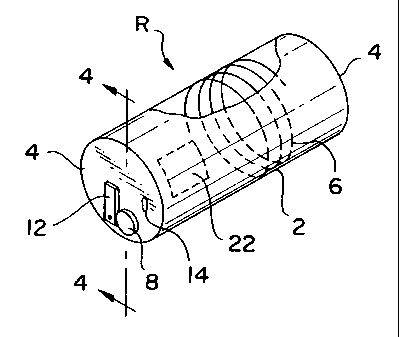Some of the information on this Web page has been provided by external sources. The Government of Canada is not responsible for the accuracy, reliability or currency of the information supplied by external sources. Users wishing to rely upon this information should consult directly with the source of the information. Content provided by external sources is not subject to official languages, privacy and accessibility requirements.
Any discrepancies in the text and image of the Claims and Abstract are due to differing posting times. Text of the Claims and Abstract are posted:
| (12) Patent: | (11) CA 2398218 |
|---|---|
| (54) English Title: | EMERGENCY VISION APPARATUS |
| (54) French Title: | APPAREIL DE VISION A UTILISER EN CAS D'URGENCE |
| Status: | Term Expired - Post Grant Beyond Limit |
| (51) International Patent Classification (IPC): |
|
|---|---|
| (72) Inventors : |
|
| (73) Owners : |
|
| (71) Applicants : |
|
| (74) Agent: | SMART & BIGGAR LP |
| (74) Associate agent: | |
| (45) Issued: | 2005-12-20 |
| (86) PCT Filing Date: | 2001-01-29 |
| (87) Open to Public Inspection: | 2001-08-02 |
| Examination requested: | 2002-07-24 |
| Availability of licence: | N/A |
| Dedicated to the Public: | N/A |
| (25) Language of filing: | English |
| Patent Cooperation Treaty (PCT): | Yes |
|---|---|
| (86) PCT Filing Number: | PCT/US2001/000659 |
| (87) International Publication Number: | WO 2001054976 |
| (85) National Entry: | 2002-07-24 |
| (30) Application Priority Data: | |||||||||
|---|---|---|---|---|---|---|---|---|---|
|
An emergency
supplementary vision device (R)
comprises a collapsible tube (2) made
of airtight material and having an
expanded form and a compact stowed
form; first and second clear member
(4)s disposed at respective first and
second ends of the tube to enable the
user to see through the tube and observe
a source of information at the other end
while smoke or other particulate matter
is in the environment: and a filter (8)
operably associated with the tube (2)
to filter the ambient atmosphere and
fill the interior of said tube with clear
air when the tube (2) is expanded to its
expanded form.
L'invention concerne un dispositif (R) de vision supplémentaire à utiliser en cas d'urgence. Ce dispositif comprend un tube (2) démontable fabriqué dans un matériau étanche à l'air et présentant une forme étendue et une forme compacte repliée; un premier et un second élément (4) transparents placés respectivement aux première et seconde extrémités du tube permettant à l'utilisateur de voir à travers le tube et d'observer une source d'informations se trouvant à l'autre bout alors que de la fumée et d'autres matières particulaires se trouvent dans le milieu; et un filtre (8) associé de manière fonctionnelle au tube (2), destiné à filtrer l'atmosphère ambiante et à remplir l'intérieur du tube (2) d'air pur quand le tube est dans sa forme étendue.
Note: Claims are shown in the official language in which they were submitted.
Note: Descriptions are shown in the official language in which they were submitted.

2024-08-01:As part of the Next Generation Patents (NGP) transition, the Canadian Patents Database (CPD) now contains a more detailed Event History, which replicates the Event Log of our new back-office solution.
Please note that "Inactive:" events refers to events no longer in use in our new back-office solution.
For a clearer understanding of the status of the application/patent presented on this page, the site Disclaimer , as well as the definitions for Patent , Event History , Maintenance Fee and Payment History should be consulted.
| Description | Date |
|---|---|
| Inactive: Expired (new Act pat) | 2021-01-29 |
| Common Representative Appointed | 2019-10-30 |
| Common Representative Appointed | 2019-10-30 |
| Change of Address or Method of Correspondence Request Received | 2018-01-12 |
| Inactive: IPC from MCD | 2006-03-12 |
| Inactive: IPC from MCD | 2006-03-12 |
| Grant by Issuance | 2005-12-20 |
| Inactive: Cover page published | 2005-12-19 |
| Pre-grant | 2005-10-06 |
| Inactive: Final fee received | 2005-10-06 |
| Notice of Allowance is Issued | 2005-05-13 |
| Letter Sent | 2005-05-13 |
| Notice of Allowance is Issued | 2005-05-13 |
| Inactive: Approved for allowance (AFA) | 2005-05-03 |
| Amendment Received - Voluntary Amendment | 2005-03-01 |
| Inactive: S.30(2) Rules - Examiner requisition | 2004-12-13 |
| Inactive: IPRP received | 2003-06-10 |
| Amendment Received - Voluntary Amendment | 2003-02-06 |
| Inactive: Cover page published | 2002-12-10 |
| Inactive: Inventor deleted | 2002-12-06 |
| Letter Sent | 2002-12-06 |
| Inactive: Acknowledgment of national entry - RFE | 2002-12-06 |
| Application Received - PCT | 2002-09-24 |
| Amendment Received - Voluntary Amendment | 2002-07-25 |
| National Entry Requirements Determined Compliant | 2002-07-24 |
| Request for Examination Requirements Determined Compliant | 2002-07-24 |
| All Requirements for Examination Determined Compliant | 2002-07-24 |
| National Entry Requirements Determined Compliant | 2002-07-24 |
| Application Published (Open to Public Inspection) | 2001-08-02 |
There is no abandonment history.
The last payment was received on 2005-11-21
Note : If the full payment has not been received on or before the date indicated, a further fee may be required which may be one of the following
Please refer to the CIPO Patent Fees web page to see all current fee amounts.
Note: Records showing the ownership history in alphabetical order.
| Current Owners on Record |
|---|
| BERTIL R. L. WERJEFELT |
| Past Owners on Record |
|---|
| None |